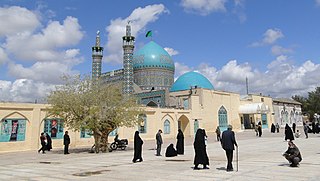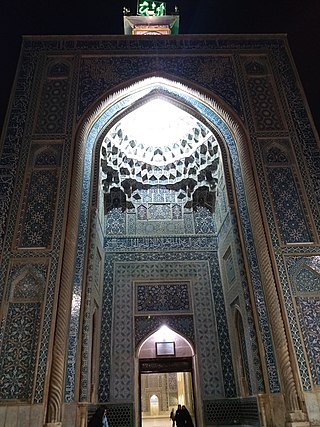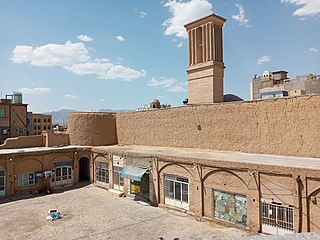
Razavi Khorasan province is one of the 31 provinces of Iran, located in northeastern Iran. Its capital is the city of Mashhad, the second-most-populous city in Iran.

Kashmar is a city in the Central District of Kashmar County, Razavi Khorasan province, Iran, serving as capital of both the county and the district. Kashmar is near the river Shesh Taraz in the western part of the province, and south of the province's capital Mashhad, in Iran, from east to Bardaskan, west to Torbat-e Heydarieh, north to Nishapur, south to Gonabad. Until two centuries ago, this city was named Torshiz (ترشیز).

The Jameh Mosque of Nain is the congregational mosque of Nain city, within Isfahan Province of Iran. Although the mosque is one of the oldest in Iran, it is still in use and is protected by Iran's Cultural Heritage Organization.

Jameh Mosque of Qazvin is one of the oldest mosques in Iran, and is the grand, congregational mosque of Qazvin, in Qazvin Province, Iran.

The Jāmeh Mosque of Borujerd is a congregational mosque (Jāmeh) in Borujerd, in the province of Loristan, western Iran. The mosque is the oldest mosque in the Zagros area and western Iran. It ranks as No. 228 in the Inventory of National Artefacts of Iran.

The Jāmeh Mosque of Yazd is the grand, congregational mosque (Jāmeh) of Yazd city, within the Yazd Province of Iran. The mosque is depicted on the obverse of the Iranian 200 rials banknote.

Turshiz, also known as Turaythith (طریثیث), is a medieval district and city of the Quhistan region. It corresponds to the Kashmar area, located in the present-day Razavi Khorasan Province, Iran. This region is divided into four regions Kashmar County, Kuhsorkh County, Khalilabad County and Bardaskan County.

Muslims, including Shia, Sunni, Ibadi and other branches, agree on the three holiest sites in Islam being the Masjid al-Haram in Mecca; the Masjid an-Nabawi in Medina; and the Masjid Al-Aqsa in Jerusalem.

Mohammad Jafar Abadei Mosque is a historical mosque in Isfahan, Iran. It was built in 1878 by the famous clergyman of the Qajar era, Mohammad Jafar Abadei. The mosque is famous because of its tiles and its architecture.

Jameh Mosque of Kerman is a mosque located in Kerman, Iran. The mosque was built at the time of Mubariz al-Din Muhammad, Muzaffarids, in the 14th century. The western side of the building features a high portal which has been decorated with decorative tile-works and a watch tower.

Amin al-tojar Caravansarai is a caravanserai related to the Qajar dynasty and is located in Kashmar. This Caravansarai is opposite the Jameh Mosque of Kashmar.

Jameh Mosque of Sari is related to the Qajar dynasty and is located in Sari, the district of Chinarban. The Jameh Mosque of Sari is located in Nargesiye daily market in Chenarbon district in Sari, the capital city of Mazandaran Province, in North of Iran. It dates back to pre-Islam era and used to be a fire-temple of Zoroastrians of Iran in the North, next to the Caspian Sea. After the acceptance of Islam by the people in the region, a mosque, known as Jameh Mosque, was constructed on the site of the temple. It is the first mosque built in the North of Iran.

Jameh Mosque of Bandar Abbas or Jameh Mosque of Delgosha is one of the oldest mosques in Bandar Abbas, the capital of Hormozgan province in southern Iran.

The Jameh Mosque of Dezful first and oldest mosque built in Dezful, located in the Dezful County, is located on Imam Khomeini Street. The construction of this mosque is a Sasanian architecture style.

The Jameh Mosque of Gonabad is related to Khwarazmian dynasty and is located in Gonabad.

The Jameh Mosque of Lar was built by the Safavid dynasty and is located in Larestan County, south of Fars province.

The Jameh Mosque of Semnan is a building in Semnan, Iran. Over time, there have been many changes and developments to the mosque, but now traces of the Seljuq dynasty and Timurid eras can be seen in it. It is believed that this mosque was built in the first century AH on the ruins of a fire temple. The building is built in Azerbaijani style.

Jameh Mosque of Shushtar related to the Caliphate of Hasan al-Askari, Abbasid Caliphate And was built in Shushtar.

The Jameh Mosque of Khorramshahr is the grand, congregational mosque (Jāmeh) of Khorramshahr city, within Khorramshahr County, Khuzestan Province, Iran. The mosque is one of the historical places of Khorramshahr city. This building is a place where people of the city come there to worship together.


























